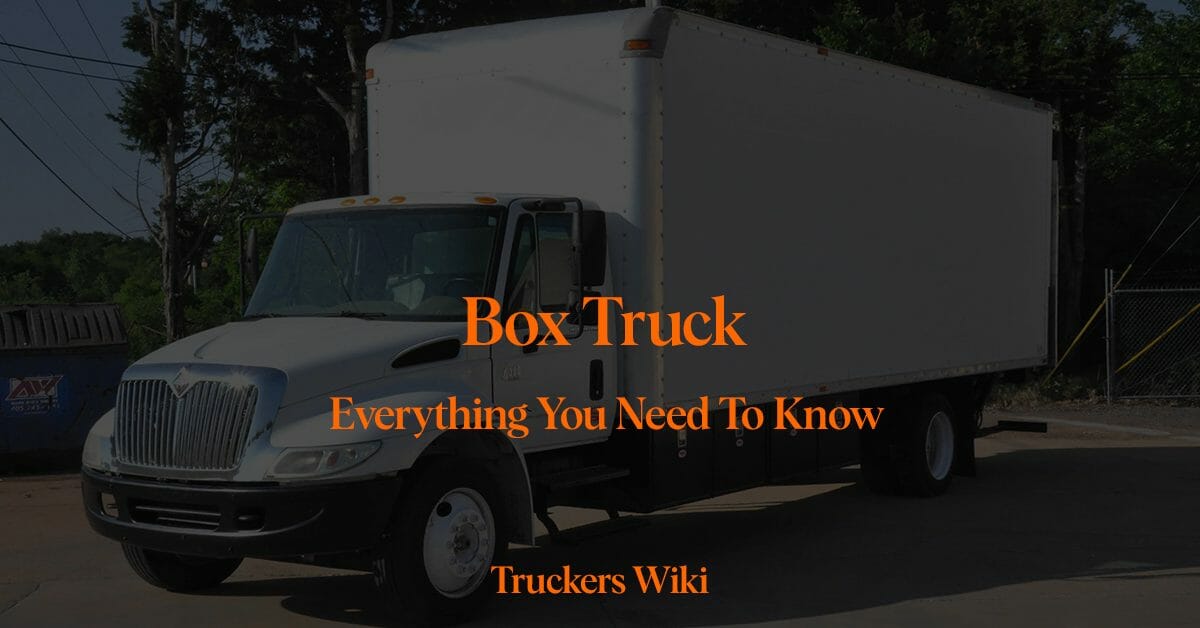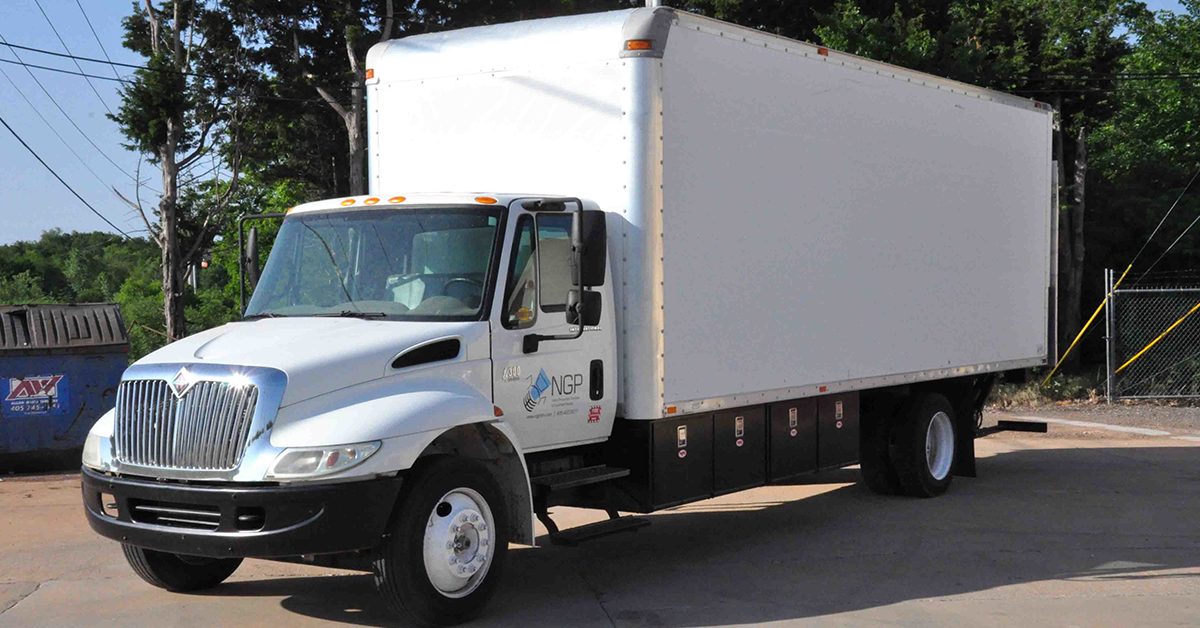
Table of Contents
What Is a Box Truck?
A box truck also known as a cube truck, cube van, rolling toaster, box van, or straight truck – is a truck with a cuboid-shaped cargo area.
It is one of the most popular commercial motor vehicles (CMV) in the freight transportation industry.
The term box truck is a reflection of the vehicle’s shape, and its purpose: to transport boxed, palletized, or other packed goods. Renowned for their convenience and versatility, box trucks are a major asset within the cargo transportation industry.
Anatomy of a Box Truck
The standard box truck comprises two primary elements: the cab, which is the driver’s area, and the cargo area or box.
Cab: Depending on the truck’s design, the cab can either be flat-faced, with the engine underneath, or it could be more traditional, with the engine in front of the driver, similar to a pickup truck. The flat-faced design allows for better maneuverability and more cargo space, while a conventional cab might offer slightly better fuel efficiency due to its streamlined shape. While the majority doesn’t have sleeper, some models do.
Cargo Area or Box: This is the defining feature of the box truck. The box is typically a rectangular, windowless space with rear doors that either open to the sides or upwards. Some models also feature a side door for more accessible loading and unloading. The box is generally constructed from aluminum or fiberglass, materials chosen for their combination of strength and lightness.
Box Truck Sizes
In terms of overall size, including the cab and engine, a box truck can range from approximately 20 feet in total length for smaller models, up to around 35 feet for the largest models. The height of box trucks, excluding cargo, is typically around 7-10 feet. Again, the actual dimensions can vary based on the truck’s specific make and model.
Small – Light Duty Box Truck Size
10-12 Feet
These are the smallest box trucks, similar in size to a large van. The cargo space typically measures around 10-12 feet in length, 6 feet in width, and up to 6 feet in height. They are suitable for small moves, such as a studio or a one-bedroom apartment.
Medium Duty Box Truck Size
14-17 Feet
These box trucks provide more cargo space and are suitable for moves involving a small house or a two-bedroom apartment. The cargo space is generally 14-17 feet in length, 7 feet in width, and up to 7 feet in height.
Large – Heavy Duty Box Truck Size
20-26 Feet
These are the largest box trucks and are similar in size to a small semi-truck. The cargo space typically measures between 20-26 feet in length, up to 8 feet in width, and 8 feet in height. They are suitable for large moves, such as a three or four-bedroom house.
How Much Does a Box Truck Weigh
A light-duty box truck, such as one used for local deliveries or small moving jobs, might have a Gross Vehicle Weight Rating which is the maximum weight a vehicle can safely carry including its own weight of around 10,000 to 12,000 pounds.
Larger, heavy-duty box trucks, like those used for larger deliveries or commercial freight, may have a GVWR of up to 26,000 pounds.
Usage and Applications
Box trucks are predominantly used in freight transportation and are a perfect vehicle in residential zones. Straight trucks are also a popular choice for expedited shipping.
Small to medium businesses use them for local and short-distance delivery purposes due to their versatility and maneuverability.
Businesses that commonly utilize box trucks include:
Carriers
From expedited shipping to OTR, this is a versatile vehicle in the trucking industry.
Learn about Carrier here.
Retailers
Businesses, such as furniture retailers, often use box trucks to deliver products to customers.
Couriers
Courier companies use box trucks for parcel delivery, especially for large or bulk items.
Food and Beverage
Refrigerated box trucks are used for transporting perishable goods.
Production companies
In the entertainment industry, box trucks are used to transport equipment to and from locations.
Moving companies
Also a popular choice for moving services due to their spacious interiors and easy loading.
Types of Box Trucks
There are several types of box trucks, each serving a unique purpose:
Dry Vans
These are standard box trucks used for moving non-perishable freight.
Refrigerated Box Trucks
These are equipped with refrigeration units to transport perishable goods such as food and medical supplies.
Utility Box Trucks
These have compartments and shelves to store tools and equipment, making them ideal for tradespeople such as electricians and plumbers.
Liftgate Box Trucks
These trucks have a mechanical lift on the back for easy loading and unloading of heavy items.
Learn more about Liftgate here.
Notable Box Truck Manufacturers
Several manufacturers produce box trucks, each with their specific designs and features:
Isuzu
Isuzu is one of the largest producers of box trucks. Models like the Isuzu N-Series are well-regarded in the industry for their reliability and durability.
Freightliner
Known for their heavy-duty trucks, Freightliner also produces reliable box trucks like the M2 model.
Ford
Ford’s E-Series cutaway models are commonly converted into box trucks.
International
International’s Durastar series of medium-duty trucks are popular choices for box truck applications.
Requirements for Driving a Box Truck
In most cases, a standard driver’s license is enough to drive a box truck, as long as it has a Gross Vehicle Weight Rating (GVWR) of less than 26,001 pounds. However, for larger box trucks or certain types of cargo ie. hazardous materials, a commercial driver’s license (CDL) might be necessary.
The requirements for driving a box truck can vary depending on the size of the vehicle, the region or country in which you are driving, and the nature of the goods being transported. Here are some general guidelines:
Valid Driver’s License
In many places, a regular driver’s license is sufficient for driving a box truck if the Gross Vehicle Weight Rating (GVWR) of the vehicle is under a certain limit (often 26,001 pounds in the United States). The specific weight limit can vary by location, so you should check the regulations in your specific area.
Learn more about Non-CDL trucking here.
Commercial Driver’s License (CDL)
If the GVWR exceeds the limit for a regular driver’s license, a CDL may be required. This often includes vehicles used for hauling hazardous materials, or vehicles designed to carry more than 16 people, including the driver.
Learn more about CDL here.
Age Requirement
Typically, you must be at least 18 years old to drive a box truck within your own state (intrastate driving) and at least 21 years old to drive across state lines (interstate driving) or transport hazardous materials.
Physical and Medical Requirements
Many places require commercial drivers to pass a physical exam to ensure they’re capable of operating the vehicle safely. This can include vision tests, hearing tests, and other health assessments.
Clean Driving Record
Employers often prefer drivers with clean driving records, and some insurance companies require this as well. A history of violations or accidents could disqualify you from certain driving roles.
Experience or Training
Some employers prefer drivers who have previous experience with similar vehicles, or who have completed a professional driver training course. These courses can provide instruction on safe driving techniques, defensive driving, cargo handling, and other relevant topics.
Special Endorsements
Depending on the nature of the cargo, additional endorsements may be required on your license. For example, transporting hazardous materials would require a HazMat endorsement, which involves additional testing.
Learn more about CDL endorsements here.
Knowledge of Regulations
Drivers should have a good understanding of the rules and regulations pertaining to commercial driving in their operating area. This includes restrictions on hours of service, requirements for rest periods, procedures for cargo securement, and more.
Maintenance of Box Trucks
Regular maintenance is crucial for box trucks to ensure they operate efficiently and safely. Routine maintenance typically involves checking and changing the engine oil and other fluids, inspecting the brakes, tires, and lights, and ensuring that the cargo box and its doors are in good working order. Preventative maintenance can help identify potential issues before they become costly problems.
Box trucks play the main role in various industries, from moving services to retail deliveries. Their versatility, convenience, and ease of operation make them a valuable asset for businesses across the globe.
As the industry evolves to meet environmental challenges and adopts new technologies, the ubiquitous box truck will undoubtedly adapt to continue meeting the needs of the global economy.
Do you need a CDL to drive a box truck? Learn more here.
Learn about Truck Maintenance here.
Learn more about Tow Truck here.
External Links
Ways to Maximize Fuel Efficiency on Box Trucks – article by – Panorama Insurance Agency – click here.
YouTube video of a Penske’s International 2020 box truck.
FMCSA on Interstate commercial driving – click here.
Box Truck FAQ
Due to the size and the ability to operate in residential areas, box trucks are a popular choice among shippers. Expedited shipping is another major area where these trucks shine.
Yes, box trucks are generally required to stop at weigh stations. Criteria is if commercial vehicle has a GVWR of more than 10,000 pounds its required to stop at weigh station.
Requirements can vary by state. Some states may have different weight thresholds, or they might offer specific exemptions based on the type of cargo, the vehicle’s purpose, or the distance traveled.
Box trucks are not allowed. Vehicles classified as commercial, including box trucks, are prohibited from the Parkway north of Exit 105.
Yes, box truck drivers are required to pass DOT physical exam if they are operating their vehicle in commercial purposes.
Running intrastate compared to interstate might have slight variations, but even if you fall under state laws there is probably a medical exam exactly the same as the one required by FMCSA.

You can listen to the article here
Last modified: February 29, 2024

